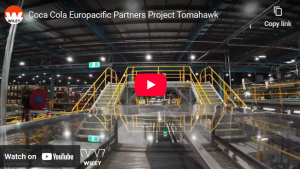Supply chains in the food industry are innovating and evolving as fast as any other. The dairy sector is on the cusp of a period of revolution powered by technology and data. Wiley’s Commercial Technology Director, Brett Wiskar explores the coming revolution.
As industry innovates we see a range of new trends and the broad concepts of automation, big data, and intelligent systems are infiltrating our food supply chains. The dairy industry is not immune to these concepts and the generational change technology brings will impact all parts of this market.
With the first milking machine making its debut more than a century ago and the current breed of automated milking systems being introduced in the 1970s, some may believe that dairies are already highly automated. Since the seventies the automated equipment have enabled the industry, adding scale, reliability, improved hygiene, and a dramatic reduction in labour requirements. Although they’ve provided incremental enhancements to their core concept, the value they offer the dairy farmer is more or less the same. In the next five years this will all change.
Semi-automation makes way for autonomy
Leading manufacturers of autonomous dairy systems are bringing sophisticated systems to market that allow dairies ranging in scale to rely on highly automated operations. This level of autonomy doesn’t just provide returns through reduction in labour in the act of milking, it allows dairy farmers to operate efficiently across their business with minimal labour and high levels of reliability. These systems will manage feed and dietary intake of livestock, monitor the yield of each animal and moderate or adjust the feed to maximise the output of each animal in the herd. Data and autonomy empowers farmers to learn from every variable in their operation and respond to changes by adjusting the operation on the fly.
Like most farming, historically dairy farmers used painstaking attention to refine and enhance the operation through generations of lessons on feed, yield, breeding and operations. Issues were identified and resolved through observation, trial and error. In the next generation of dairies, farmers will learn from improvements in one small aspect of the operation in real time and make changes remotely across their entire operation.
This generation of change in the dairy industry is part of a global trend known as Industry 4.0 or the Fourth Industrial Revolution. The level of innovation in these operations coming in the next decade will see the end of semi-automated dairies. Dairies that embrace automation and data driven insights across their operation will have significant operational advantages over the semi-automated operations that have been commonplace in the past.
Data will be the difference
Dairy farms will have all aspects monitored across the operation; cows, feed, milk, weather, grazing locations and conditions. Data will be centralised into a private cloud allowing analysis and interrogation. The farmer will be empowered to refine the operation remotely; to close a gate, to add supplements to the feed of a particular animal, to see a report on the impact of yesterday’s decisions.
Access to operational data en masse will allow analysis leading to incremental, but importantly, sustainable improvements in a system. Optimisation is the name of the game. Improving an operation to make it more profitable and viable in the modern industry can’t be done through a sweeping change to magically transform the viability of a dairy operation. Finding a 2% increase in yield from a section of the operation might come from a combination of;
- Increases of 1% yield in milk from a quarter of the herd by changing their diet
- Greater levels of transparency leading to certain traits to be bred into the next generation of the herd
- Savings in wastage through careful tracking of volumes throughout the logistics and processing side of the product journey
All of this will be achieved with data. The automated nature of the next generation of dairy infrastructure will empower the data side of the industry in two ways. All aspects of the operation, from the grass and feed to the end product to be tracked and measured. It is these systems that track and measure the process that will also allow the farmer to make the changes needed to drive their operation into the future.
In the era to follow, machine learning and predictive analytics will bring yield to the business on a micro level by identifying data trends and making alterations across the business that the farmer would never have found. Although the gains will be minute, they will have a large cumulative impact when considering the entire industry.

The power of combined knowledge
The true power of big data is derived from the scale of the data an organisation is able to interrogate. In May 2015 Google Ventures invested US$15 million in a US based start-up, Farmers Business Network. This organisation allows farmers of planted agriculture, to upload all data in their farming operation and benefit from learnings available to the group. Each farmer’s data is anonymous and pooled with data from farms with a similar location, crop type, rainfall, fertiliser strategy etc. Via Farmers Business Network, farmers access and benefit from pooled data and combined learning experiences.
Data pooling for combined learning will come to the dairy industry in the next few years. Supplied from one of two sources,either; large scale dairy operations looking to empower their supply chain and gain visibility into the farms that are the source of their product, or from the manufacturers of the autonomous systems.
The future of dairies will favour the brave
The semi-automated nature or our current dairy industry model allow a comparatively painless transition to a more autonomous supply chain. Many industries are moving from high levels of labour intensive processes but dairies have been incrementally minimising labour for decades. When the power of data and full automation begin delivering genuine returns a wave will sweep through the industry driven by early adopters seeking to get the jump on those around them. The technology already exists and real world case studies are easily found. Australia’s industry will shift rapidly leading to acquisitions, changes in co-operatives and alternatives to the traditional channels a dairy farmer had at their disposal.
Those who move decisively to adopt a technology and data driven approach to their operations will be the powerful players in the industry of the next generation.
Interested in discussing data further? Speak to Brett today.



